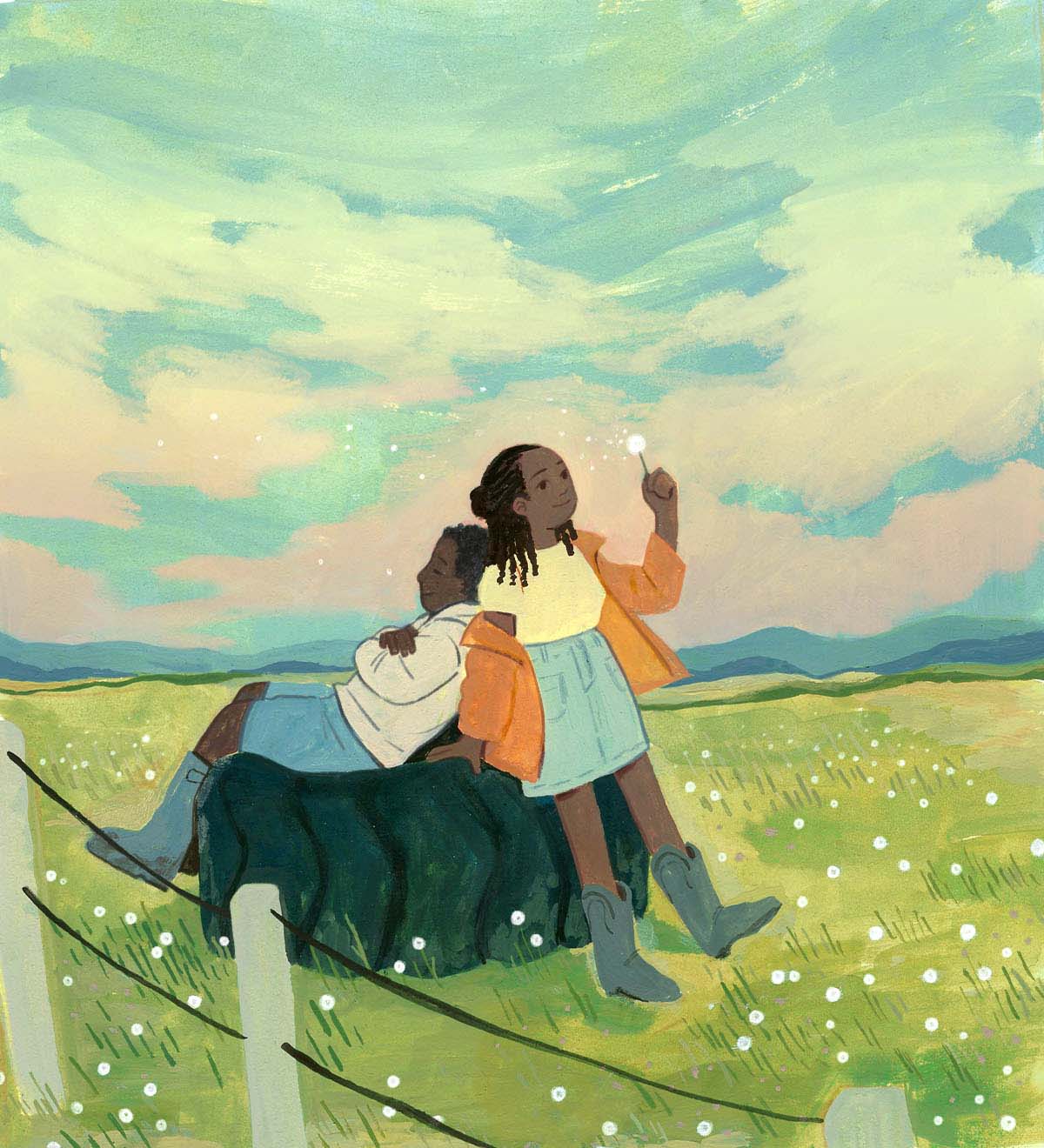Everyone has that one show that pops up in the “Top Picks” section of Netflix they know they’re going to watch eventually. In my case, it was Virgin River. After I’d revisited my other favourite shows for the third time, I gave in.
It’s easy to see the series’s appeal. It has a somewhat nostalgic Gilmore Girls quality to it—a young white woman takes refuge in a small town where the scenery is beautiful and the local characters are familiar and likable. But another, perhaps less obvious, trope I noticed was that of the lone Black character, a beloved and misunderstood sidekick. Virgin River’s John “Preacher” Middleton, played by Colin Lawrence, is the male lead’s quiet and dependable best friend. He’s an army veteran and a chef with an organic vegetable garden, but the first few seasons of the show don’t reveal much else about him.
Preacher’s secondary status in the show is all too familiar to me. (In Gilmore Girls, Yanic Truesdale’s cranky French character, Michel Gerard, doesn’t get much of an arc, either, over the original show’s seven seasons.) As I watched, I kept wondering: What is his story?
I didn’t grow up in a small town. Lethbridge, Alberta, had a population of about 80,000 to 90,000 when I lived there, but it had a small-town mentality. I could often count the number of other Black families around me on one hand, and it was difficult being always aware that I stood out as one of the few minorities—especially when I didn’t see my own experience reflected in pop culture.
The lone Black characters in shows like Virgin River, Gilmore Girls, and also Schitt’s Creek reinforce the stereotype that Black people do not belong in small towns. It would seem Black characters’ stories are worth exploring only if they fit a certain profile. But if we assume that Black stories exist just in big cities, we fail to embrace the full picture of what being Black is and could be.
Black characters are often used “to accentuate white trials and tribulations and drama and comedy,” says Debra Thompson, associate professor and Canada Research Chair for Racial Inequality in Democratic Societies at McGill University. In Canada, as in the US, predominantly white towns are seen as “quaint” and “charming,” says Thompson, “precisely because there are no Black people there.”
Historically, the migration of Black people to cities over the past hundred-odd years has contributed to the cultural narrative that Black equals urban. Through the West Indian Domestic Scheme in the 1950s and ’60s, for example, many Black women from the Caribbean were recruited as domestic workers for wealthy white families, usually in the larger cities of Toronto and Montreal. When this policy ended in 1968, new Black immigrants sought out established family members and Black communities in those cities.
Statistics Canada’s latest census numbers show that many immigrants are now ending up in smaller communities—outside of key cities like Toronto, Montreal, and Vancouver. And though they don’t make up the majority of newcomers to Canada, a growing number of immigrants are Black. Some may choose to settle in smaller cities and towns. Whether they would feel they belong there is another story.
Misha Maseka and her family moved to Canada from Australia around 2004, when she was twelve. Her father is a practising physician who, Maseka says, has a heart for rural areas. That was why he was drawn to Drumheller, an Alberta town with a population of about 8,000 at the time. Maseka’s was one of the only Black families there.
Maseka remembers the curiosity and stares directed at her and her family when they arrived, with kids often asking her ignorant questions about her skin, like whether she tanned in the sun. “And I don’t mean ‘ignorant’ in a negative sense,” she says. “Literally just like: well, this is your first time interacting with a person with this much melanin, so you’re going to ask a random question like that.”
I am surprised when Maseka tells me she loved growing up in Drumheller. Her parents built a community within the town and among the families of different ethnic backgrounds living nearby. She now works as a filmmaker and writer in Calgary, and though it makes more sense for her to live in a big city for work, she hasn’t ruled out small-town living entirely. She continues to seek out the kinds of close-knit connections she had back in Drumheller.
In hindsight, Maseka says, it’s clear that her family’s success hinged on being accepted. “There was something very palatable about my family assimilating,” she says. She was involved in music activities, and her siblings played basketball and football—interests that likely lined up with the town’s social expectations of them. “All their interactions of Black people in 2004 would have been whatever they saw on television,” she says, “which is sports and Destiny’s Child.”
Dieulita Datus has made it her personal mission to create a more welcoming space for Black people and other people of colour in small towns in central Alberta. She moved from the Bahamas to Lacombe, Alberta—a city of just over 10,000—for university in 2007. She was attracted by the diversity displayed in the University of Lacombe’s admissions brochure, she says, and expected an “amazing” experience. She soon learned the advertised diversity was limited to pockets of communities within the school and the town, with Africans connecting with other Africans, Koreans with other Koreans, and so on.
“You knew . . . exactly who the Black families were, who the Black professors were, who the Black students were,” she says. “If you went to a grocery store and someone saw you, you automatically became family and friends.”
After university, Datus decided to stay in Lacombe. She embraced living on a farm, going tobogganing in the winter, and watching hockey. She had forged a diverse community of friends. Yet, wherever she went, she was often treated as though she weren’t local. Strangers or new acquaintances tended to assume she was still just a university student and often asked her where she was from, how long she had been in Lacombe, and how she got there.
“The third question really got me the most because I never knew how specifically to answer that,” she says. “Do you want me to say, ‘By plane,’ ‘By boat’?” Around 2014, Datus attended a local country music concert with some friends, all of whom were white. When they were leaving, a man began to point at Datus and yell at her, telling her to go back to where she had come from. “I think my response was, ‘I’m from here, I live in Lacombe,’ and he was like, ‘That’s not what I mean,’ and it got really, really bad,” Datus says. After the man began using racial slurs, a friend intervened and the clash turned physical. “I was afraid because now I felt [that] if I wasn’t there or if I wasn’t different,” she says, “my friend would not have to be involved in a physical altercation on my behalf.”
A few years ago, Datus befriended Sadia Anwar, who was consistently the only other woman of colour Datus would see at events she attended. Together, they co-founded a community-centred organization they called Ubuntu, a term in Zulu and in South African philosophy that means “I am because we are.”
When Ubuntu officially launched in June 2020, it was immediately thrown into the wave of social and political anti-racism activism which took hold that summer. The organization held rallies in several towns and facilitated conversations with local governments and policy agencies, among other activities. But Anwar, who grew up in Calgary after her family immigrated to Canada as refugees, says central Alberta still has a way to go when it comes to inclusion. When Anwar and Datus urged Lacombe’s city council to hold public anti-racism conversations during the Black Lives Matter protests, they received all kinds of excuses for not doing so—including, says Anwar, “‘Well, we don’t want to expose folks to this kind of trauma.’”
Lately, Ubuntu’s work has been shifting from activism toward offering community services. “It could be things like a Black person wanting to have support in going to court because they don’t know what it’s going to be like,” says Datus, who now lives in Red Deer. “It could be something like working with a mom whose kid is experiencing racism in a school and walking her through that.”
Datus sees more families that are Black or other racial minorities choosing to live in central Alberta. “I want the young folks of colour—the young Black folks growing up in Red Deer, growing up in Lacombe—to be able to see each other,” she says, “to the point that they don’t have to count how many Black students are in their schools.”
Shayna Jones defied her own assumptions about herself when she moved right outside of the small lakeside village of Kaslo (population: just over 1,000), in the southern interior of British Columbia, in 2016. She grew up in Vancouver and was “totally city” for most of her life; small-town living, she says, wasn’t on her radar. But when close friends moved to Kaslo and invited her and her family to try rural living, she decided to take the leap.
As one of the few Black women in town, she is constantly mistaken for one of the others. But it’s when Jones leaves town that she notices her otherness the most. When she went to Washington, DC, for a family wedding last spring, Jones says, she began to fully notice the subconscious toll that being a visual minority back home had been taking on her. “It comes to light when I’m in the context like I was in Washington, DC, where I’m just unremarkable, and it feels beautiful.”
The lack of cultural diversity in Kaslo is a burden Jones says she feels most acutely when she looks at her three young children, who are all biracial. “They’re raised to have strength and dignity in their Black heritage,” she says, “but I know that it is going to be deeply—and it is already deeply—ingrained for them that the baseline of what is typical is white.” As much as she can, she says, she has to teach them how to counter the ambient, unspoken assumption “that normal is white and Blackness or colour is exotic.”
And yet, living in the remoteness near Kaslo has become foundational to Jones’s life. As a folklorist and performative artist, she has found a connection to her ancestry and heritage by living on the land. “And how I tell stories is directly influenced by the land that I’m living on,” she says.
Jones has dedicated the past several years to “Black and Rural,” an online gallery featuring videos, interviews, poetry, music, and other media that Jones collected over two years to showcase some of the nuances of what it means to be Black and living in the countryside. “I come from this country, and this country may never really have a place for me as I would want it to be, like in my complexity of who I am,” says one voice in “No Witness,” a video featuring anonymous sound bites from various interviews. The project, which Jones adapted into a theatre production that premiered this past spring, is part of her work to, in her words, “defy the monolith of what matters to Black lives.”
The stories of Black people—in rural areas and small towns in particular—have only recently been given space or airtime. Last year, journalists Omayra Issa and Ify Chiwetelu created the CBC multimedia project “Black on the Prairies” to chronicle the Black experience in Alberta, Saskatchewan, and Manitoba. (Issa has since announced on Twitter that she’s signed a book deal to write about the “richness of Black prairie life.”)
To me, Issa and Chiwetelu’s work is a step in the right direction, but it is still a work of non-fiction. Pop culture has yet to catch up. “When popular culture thinks of Blackness, rarely does somebody think of a tiny little town or a mountainside and the Black person who’s there,” says Jones. “I want to be a part of revealing that this thread—that Black skin—can be even on the side of a mountain.” And maybe, someday, I’ll get to binge-watch a show about that.






